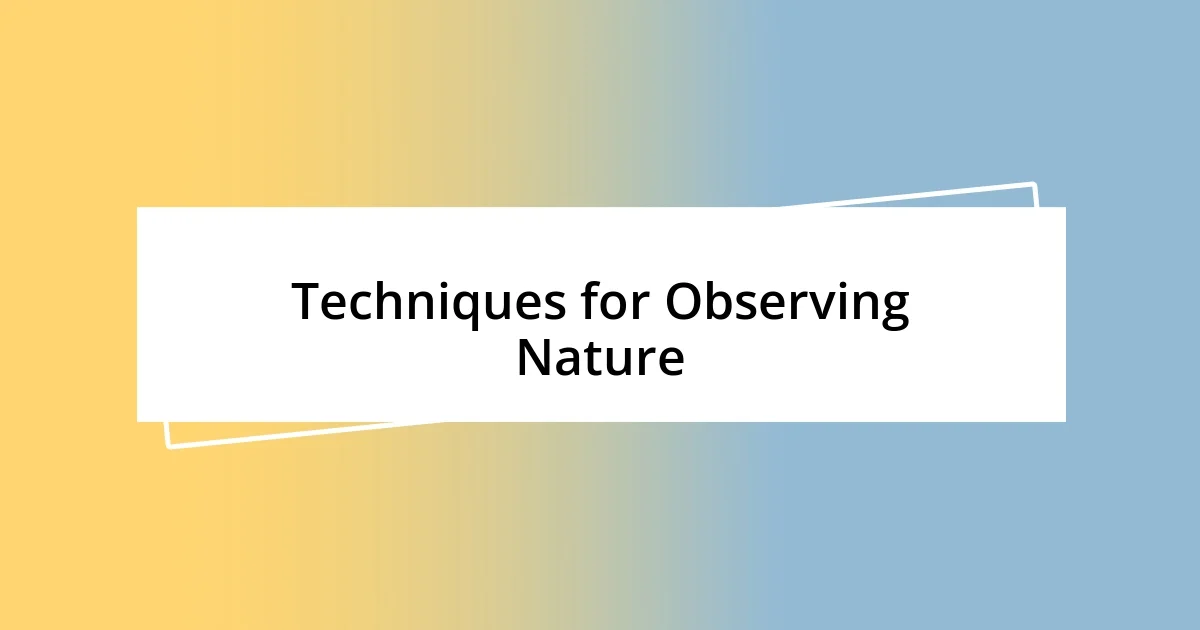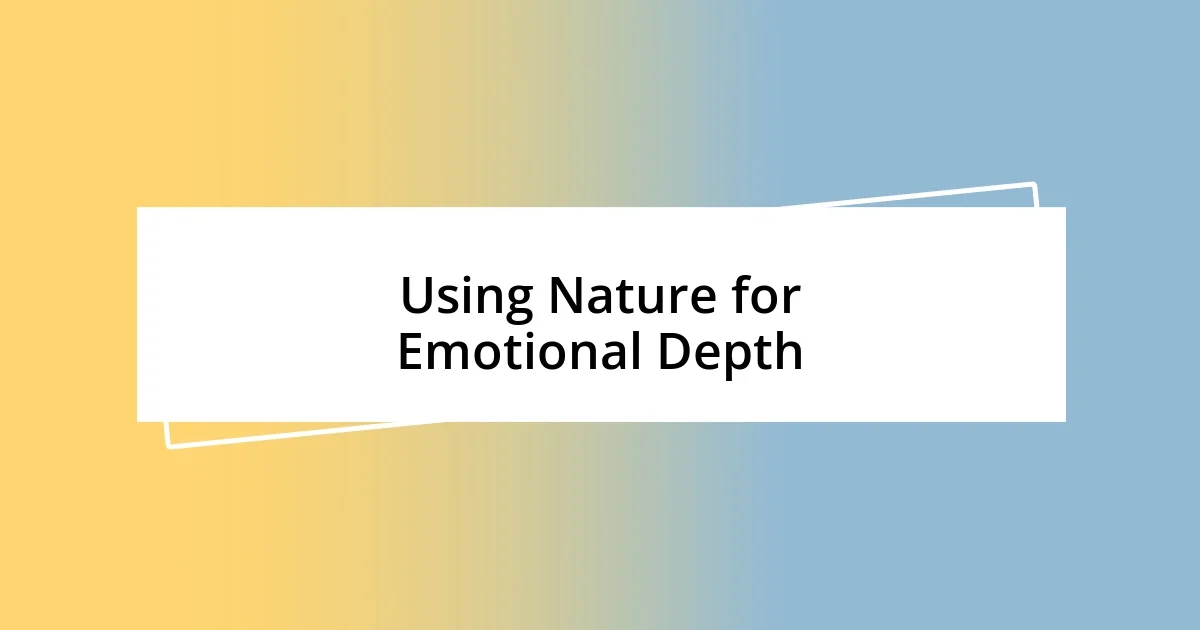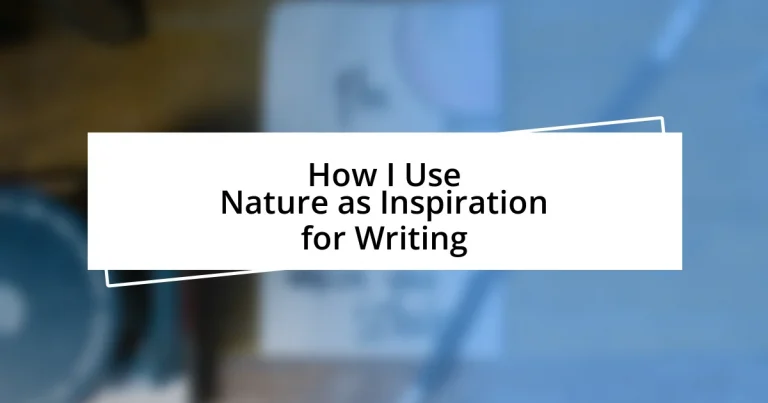Key takeaways:
- Nature acts as a powerful source of inspiration, influencing themes of change, resilience, and emotional depth in writing.
- Engaging all senses, journaling, and mindful observation enhance the writing process by fostering a deeper connection with the natural world.
- Creating a routine that incorporates nature, such as daily walks or outdoor brainstorming sessions, helps unlock creativity and generate new ideas.

Understanding Nature’s Influence
Nature has a unique way of stirring my creativity. I remember walking through a sun-dappled forest, where the leaves whispered stories of ancient times. Have you ever felt the rustling of leaves ignite a thought? It’s as if the world around us is a wellspring of inspiration, waiting to be tapped into.
One day, while sitting by a serene lake, I felt a wave of clarity wash over me as the ripples danced across the water. It struck me how nature’s rhythms mirror our own, encouraging me to explore themes of change and tranquility in my writing. Isn’t it fascinating how a simple moment in nature can lead to profound insights?
The vibrant colors of a sunset ignite a sense of possibility in me. I often find myself pondering—what stories could that sky tell if it could speak? Nature’s beauty compels me to weave emotion into my words, drawing connections between the landscape and human experience. It’s this profound interplay that truly inspires me to write.

Finding Nature’s Themes in Writing
Finding themes in nature offers a treasure trove of inspiration for any writer. For instance, I often contemplate the tenacity of a wildflower growing through a crack in the pavement. It serves as a poignant reminder of resilience in the face of adversity—a theme I love exploring in my storytelling. Have you ever noticed how nature’s endurance can mirror the struggles we face in life?
During a hike last summer, I stumbled upon a calming babbling brook, which sparked an idea about the passage of time. The constant flow of water made me reflect on how life ebbs and flows, echoing the themes of movement and stillness I often write about. It’s amazing how these moments can hone in on the essence of life’s journey, isn’t it?
Moreover, the cycle of seasons is another theme that profoundly influences my work. Each change—from the vibrant blooms of spring to the quiet sleep of winter—provides a backdrop for exploring emotions. I wrote several poems inspired by autumn’s bittersweet farewell, capturing that poignant transition as I observed the leaves falling. Nature articulates life’s ebb and flow so beautifully, and I strive to mirror that poetic rhythm in my writing.
| Nature’s Theme | Writing Insight |
|---|---|
| Resilience | Inspired by wildflowers; representing strength in hardship |
| Passage of Time | Reflections from a flowing brook; captures life’s journey |
| Seasonal Change | Autumn’s transition; evokes emotions of sadness and release |

Techniques for Observing Nature
Observing nature requires more than just looking; it’s about truly immersing oneself in the experience. I often find that slowing down and taking a moment to breathe in the surroundings opens up a world of details. For instance, I once spent a morning simply watching a busy ant trail. The cooperative movements and communication that seemed to occur among them fascinated me and inspired an exploration of teamwork themes in my writing.
Here are some techniques I utilize to deepen my observation of nature:
- Engage All Senses: I always focus on what I can smell, hear, see, and even touch. The sound of rustling leaves, for instance, can evoke feelings of nostalgia or warmth.
- Journaling: I jot down my immediate reactions to what I see, guiding my thoughts to deeper insights. Capturing the vibrancy of colors in a sunset has spurred many poem drafts.
- Mindful Walks: Walking without a destination allows for serendipitous observations, just like the time I spotted a forgotten bird’s nest hidden among branches. This inspired a story about the unnoticed moments in life.
- Sketching: Even if I’m not an artist, quick sketches of landscapes help me capture nuances, offering prompts for storytelling later.
- Photography: Taking pictures lets me focus on details I might miss in the moment, like the intricate patterns on a leaf that later inspired a discussion about beauty in imperfections.
These practices foster a deeper connection with the world, inviting inspiration to flow like a gentle stream in my writing.

Incorporating Natural Imagery in Text
Incorporating natural imagery in writing allows me to paint vivid scenes that resonate with readers. I recall a quiet evening spent watching stars twinkle against a deep blue sky. The stillness wrapped around me like a blanket, inspiring a scene in my novel where a character finds peace amidst chaos. Have you ever felt how the beauty of nature can evoke tranquility in your own life?
When I describe a forest, I find myself using colorful language to bring the experience to life. I try to capture how sunlight filters through the leaves, creating a mosaic of light and shadow on the forest floor. This sensory detail draws readers in, allowing them to feel the cool breeze or hear the whisper of nature around them. It’s fascinating how a richly textured description can transport someone to a completely different place, don’t you think?
Often, I use natural metaphors to express complex emotions. For instance, I might compare a character’s heartache to a wilting flower, slowly losing its petals. This connection can evoke empathy and understanding, making the narrative more poignant. Imagery acts as a bridge between readers and emotions, forging a deeper connection that is hard to achieve with plain exposition. It’s moments like these that remind me just how powerful the imagery of nature can be when woven into storytelling.

Using Nature for Emotional Depth
When I step outside and feel the chill of a brisk autumn wind against my skin, it often stirs a wave of nostalgia within me. I vividly remember a day when I walked through a sun-dappled park, surrounded by trees shedding their leaves like confetti. That juxtaposition of beauty and decay inspired me to explore themes of loss and renewal in my writing. Isn’t it fascinating how something as simple as a leaf falling can resonate with our own experiences?
Another moment stands out when I sat by a quiet river, listening to the gentle flow of water. It reminded me that emotions, like the current, can be both calming and turbulent. That experience became a metaphor for the ups and downs of relationships in one of my stories. I think about how often we overlook how nature reflects our internal struggles, don’t you agree?
When I watch storm clouds roll in, I can feel the tension building in the air—a tangible reminder of the emotional storms we all face. This powerful imagery pushes me to delve deeper into the psyche of my characters, capturing their fears and anxieties with vivid descriptions. There’s an undeniable connection between nature and emotional depth that fuels my creativity and allows me to craft narratives that truly resonate with readers. Have you ever felt how the atmosphere outside mirrors what’s happening within?

Nature Inspired Writing Exercises
Exploring nature often leads me to unique writing exercises that spark my creativity. I remember a time when I dedicated an afternoon to sketching scenes from a nearby garden, letting my pencil wander as the flowers danced in the breeze. This simple act of observation transformed into a writing prompt, allowing me to draft a poem inspired by the colors and fragrances surrounding me. Have you ever tried using your senses as a starting point for your writing?
Another exercise I enjoy involves taking a walk and jotting down the first five things I notice—sounds, sights, and even the way the air feels. One day, while walking along a path lined with wildflowers, I noted the buzzing of bees and the rustling of leaves. Later, these observations helped me create a vivid opening scene for a short story, grounding it in a specific moment that readers could visualize. It’s intriguing how a few simple notes can blossom into a cohesive narrative, isn’t it?
Sometimes, I challenge myself to write from nature’s perspective. I recall a late evening when the wind whispered through the trees, urging me to capture its voice on paper. By imagining what a tree would say about the seasons passing by, I crafted a reflective piece that delved into themes of change and resilience. This exercise not only expanded my creativity but also deepened my understanding of the world around me. Have you considered giving nature a voice in your own writing?

Creating a Routine with Nature
Creating a routine with nature is an enriching experience that deepens my connection to the writing process. I try to step outside every morning with a cup of coffee in hand, allowing the warmth of the sunrise to soak into my skin. On one particularly crisp morning, I listened to the soft chirping of birds, and it reminded me that every day is filled with new beginnings, much like the blank page I face.
Incorporating nature into my writing schedule has transformed how I brainstorm ideas. I often take my notebook to a local park, where I can sit under the shade of a grand oak tree. One afternoon, while the gentle rustle of leaves surrounded me, I found clarity in the chaos of my thoughts. Nature has this hypnotic effect that quiets my mind, allowing me to hear my inner voice more clearly. Have you ever noticed how the outdoors can pull your creativity to the forefront?
Sometimes, I’ll cycle through a serene trail lined with wildflowers, feeling the rush of wind against my face. During one ride, I caught a glimpse of a butterfly fluttering by, and it sparked the idea for a story centering on transformation and hope. These moments remind me that nature offers not just inspiration, but also a routine that keeps my creativity flowing. Isn’t it amazing how something as simple as a bike ride can unlock a world of ideas?














